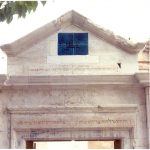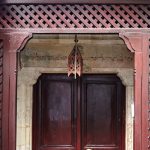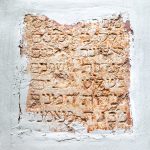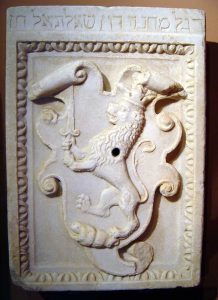Etz Hayyim has a number of Hebrew inscriptions commemorating past benefactors on the gates and walls of the synagogue, as well as a few funerary inscriptions. All of these Hebrew inscriptions date between the 15th to 17th centuries.
.

Etz Hayyim has a number of Hebrew inscriptions commemorating past benefactors on the gates and walls of the synagogue, as well as a few funerary inscriptions. All of these Hebrew inscriptions date between the 15th to 17th centuries.
.
Inscriptions on the Rothchild Gate
Above the Rothchild Gate are two dedicatory inscriptions. The uppermost inscription on the pediment refers to a donor and reads in translation: “(In the) Year 5247, 7th of Iyyar, I, Eliano Cortese, may he live forever, dedicated and built the entrance for the ransom of his own soul and for the lives of my children and grandchildren, may they live forever.” The Hebrew date corresponds to the 1st May 1487 in the Julian calendar. While Cortese was evidently an eminent personality, there is no further information about him. The second inscription above the wooden gate comprises two parts: “This is the gate of the Lord: into which the righteous shall enter”, a quote from Psalm 118:20, and “Open ye the gates, that the righteous nation which keepeth the truth may enter in”, a quote from Isaiah 26:2.

Inscription at the Entrance to the Synagogue Sanctuary
The inscription above the entrance to the synagogue reads: “For Thou will ignite my candle; The Lord my God will enlighten my darkness. (In the) year 5281. Moses son of Michael Yeniati.” Above this dedication, the Hebrew letters “Lamed-Kaf” are written which may be a Kabbalistic formula for a Name of God. The Hebrew date conforms to 1520/21 in the Julian calendar. The text is a quote from Psalm 18:29. Very little if anything is known about the mentioned, Michael Yeniati. An Abraham Yeniati is listed in Canea (Hania) in the 16th century; a Moses Yeniati in Candia (Heraklion) in 1654.

Inscription on the Caretaker’s Lodge
To the right of the door of the former shamash lodgings, now the main synagogue office, there is a small rhyming Hebrew inscription that certainly pre-dates its present location. It honours a group of people who can no longer be conclusively identified and reads enigmatically: “A memorial to the (?) priests and deputies of the priest, both the former and the latter ones, … of the residents, in three (?) years, decent in (?) troubles, (?) named among the faithful ones.” During Evlagon’s time, this inscription was obscured by whitewash, while today it is hidden by foliage during spring and summer months.

Psalm 137:5 in the Synagogue Sanctuary
In the south-east corner of the main sanctuary, the opening words of Psalm 137:5 are carved into two sandstone plaques. Psalm 137 is a hymn expressing the yearning of the Jewish people in exile after the Babylonian conquest of Jerusalem, a defining moment in Jewish history. Verse 5 evokes a self-exhortation to remember Jerusalem: “If I forget thee, O Jerusalem, let my right hand forget her cunning.”

The Saltiel Coat of Arms
Positioned next to the Memorial for the Cretan Jewish community on the outer wall of the Mikveh on the way to the southern courtyard is the Saltiel Coat of Arms, a replica of an original relief now exhibited in the Archaeological Museum of Heraklion. The text on the relief reads: “The coat of arms of Don Shealtiel Hen.” The original coat of arms was at the centre of some controversary in the mid-16th century in Candia as Heraklion was called in the Venetian period. A scandal erupted over its proposed placement above the Ehal inside the sanctuary of Candia’s Tall Synagogue which had been the request by this synagogue’s donors, the noble Saltiel family. The request was immediately rejected by the local Romaniote rabbis because this act would have violated Jewish law and as a result, the coat of arms was instead positioned outside over the entrance to the synagogue. It remained there until 1941 when the synagogue was flattened during the Nazi bombing of the city. All that remained of the building was the entrance with the in situ coat of arms above it. Some years ago, Nikos Stavroulakis, the then-Director of Etz Hayyim Synagogue identified this escutcheon in the storerooms of the Archaeological Museum of Heraklion. Four copies were subsequently cast in marble dust, one of which is now displayed at Etz Hayyim.